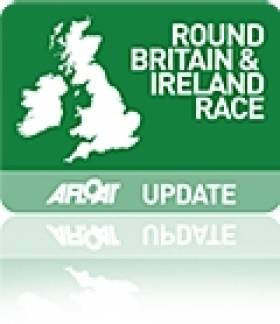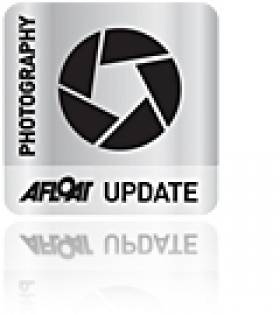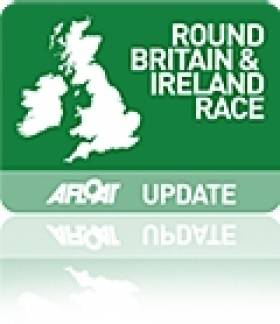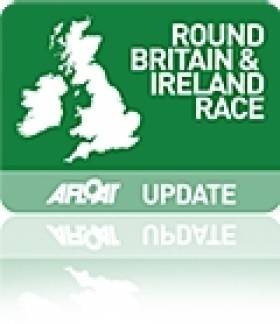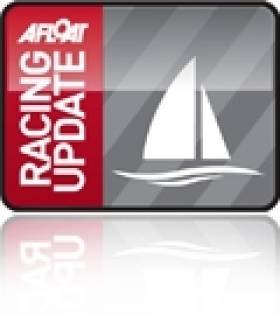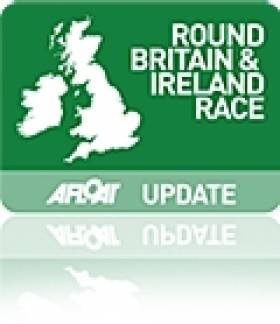Displaying items by tag: Round Britain & Ireland Race
Two-Handed Division for Round Britain and Ireland Race
The Royal Ocean Racing Club (RORC) announced today the introduction of a Two-Handed Division in the non-stop race around Britain and Ireland, sponsored by Sevenstar starting on Monday 23rd August from the Royal Yacht Squadron in Cowes. The news will be of interest to the ten double handed entries for this weekend's Round Ireland Race start from Wicklow.
RORC Racing Manager Ian Loffhagen commented: "We have been receiving a lot of interest and enquiries from competitors who wanted to race double handed in this non-stop challenge, so have made the decision to open it up to enable them to race alongside the fully crewed boats. They will race for the Rebel Maid Trophy."
"Originally we did not have a Two–Handed Division in the race out of deference to the Royal Western Yacht Club's two handed (stopping) Shetland Round Britain and Ireland Race. However when they reached their entry limit the RWYC kindly told us that they were happy for us to open our race to two handed boats."
"The Sevenstar RBI will be the most challenging race of the RORC season for the two handed fleet and we are hoping that it will appeal to the Class 40 fleet in particular. However because of the timing of this announcement the race will not be part of the Season's Points Championship for the Two–Handed Division. It is a stand alone challenge and it will be a big one at that!"
The first boat to enter the Two-Handed Division is Michel Lebrun's IMOCA 60, An Ocean of Smiles.
The Sevenstar Round Britain and Ireland non-stop race covers 1760 miles and is also open to IRC, IMOCA 60s, Class40 and multihulls. It has attracted a highly competitive and international fleet ranging from Volvo Open 70s to Mike Slade's 100ft Leopard 3 and seasoned RORC racers. The yachts will race clockwise around Britain and Ireland, starting from the Royal Yacht Squadron line and a Race Village will be set up in Cowes Yacht Haven. Competitors will be encouraged to join the party at the Race Village following the Rolex Commodores' Cup prizegiving celebrations on Saturday 21st August. The general public will be able to view the yachts taking part in the race and mingle with crews in the Race Village prior to the 1400 start on Monday 23rd August.
The Sevenstar Round Britain and Ireland Race can also be followed via the event website: http://sevenstar.rorc.org and all yachts will be fitted with a tracking device to follow the progress of the fleet. 'Armchair' sailors around the world will also have the chance to test their skills by taking part in a 'Virtual Sevenstar Round Britain and Ireland Race' which will mirror the 1760nm race. The virtual game is free to play and is designed to be as close as possible to the real thing.
Enquiries are open for the race via the Royal Ocean Racing Club: www.rorc.org.
Three Retirals from Round Britain and Ireland Race
The south-west corner of Ireland has taken three scalps since the RBI fleet departed Kinsale yesterday.
The Open 40 Livewire was observed yesterday being towed into Baltimore harbour, with co-skipper Stuart Dodd up the mast disenatangling the snuffer. The head of her spinnaker was wrapped around the top of her forestay.
Livewire said they had had 'another epic kite disaster at top speed', and said that they had sustained too much damage to other sails to carry on. They were hoping to motor back to Kinsale after boat has been checked over.
One of the front runners in the IRC fleet, Yogo Racing Izara, retired with a split mainsail, but now plans to head for Dingle to collect spare mainsail and plans to continue racing.
Quid Non is returning to Plymouth single handed as a 500-mile qualifier for the OSTAR race.
Backlash II, a 38-foot catamaran, has retired and is in Ballinskelligs Bay
Round Britain and Ireland Photos on the Gallery
Photographer Bob Bateman has added new images to the Afloat gallery from the Round Britain and Ireland race that departed Kinsale this week. The images are here.
Round Britain and Ireland Fleet Leave Kinsale
The racing fleet in the Shetland Round Britain and Ireland race have left Kinsale after their mandatory stopover, stringing around Ireland's South-west corner this morning en route to Castlebay on Barra in the Outer Hebrides.
The leading group are a mix of mutihulls and Class 40 racing yachts, facing a beat up the west coast in 20-knot winds from the north-east.
Although the first boats on the water are all high-performance racers, the leading boat after the Kinsale stopover was a Class 3 Oyster, The Shed, skippered by Pip Hare and Phil Stubbs.
The race has a live tracker HERE, and a shiny new website HERE
No Transatlantic Record for Leopard
ICAP Leopard, the 100ft super-maxi racing yacht owned by Helical Bar PLC chief executive Mike Slade, has ended her transatlantic record attempt. After a fantastic start, ICAP Leopard found herself in a windless high pressure at 02:00 UTC on Saturday 420 nm from the finish. With the record looking less and less achievable, Skipper and Boat Captain Chris Sherlock took the decision to abandon the attempt.
Having started on Saturday 29th May in New York, ICAP Leopard has had to contend with variable conditions from the start. The crew worked hard in the first few hours to position themselves correctly to pick up a weather front with enough breeze to get them up to record speed. Having achieved this, the crew were then able to keep the boat going fast through a cold and wet few days mid-Atlantic. With a record attempt of this nature the weather has to be consistently good for the entire voyage, which is hard to predict 9 or 10 days in advance. On this occasion a high pressure system on the approach to the UK blocked ICAP Leopard’s path and ended any hope of breaking the record.
ICAP Leopard Owner, Mike Slade, commented: ”We have a great yacht which has now proven itself over the last three years to be physically fast enough and powerful enough to easily churn out 500+ miles day after day and could have broken this record. However, on this occasion it materialised that the weather was not on our side and after a fantastic run at the start, the crew were forced to gybe all the way home during the latter part of the race. It just goes to prove how difficult this record is to beat and what a great boat Mari Cha IV was.”
Chris Sherlock also commented: “The crew did a phenomenal job to put us in such a great position during the first 5 days of the attempt, it is just a real shame that the forecast didn’t work out for us on this occasion. When we started we always knew that there may be a ridge of high pressure blocking our route to the finish, but we hoped that we would be able to navigate our way through without slowing too much. It is really disappointing that our record attempt was thwarted by the wind gods but no doubt we’ll be back to take on the mighty Atlantic again next year.”
ICAP Leopard was the most high-profile racing yacht to take part in the last Round Ireland, but this time around she will compete in the JP Morgan Round the Island Race on 19th June followed by a large number of corporate charters and sponsor commitments in the UK. Her next record breaking adventure will see Slade and his crew attempt to take on the Sevenstar Round Great Britain & Ireland Race starting on August 23rd this year.
Once again they will be equipped with a tracker and their adventures can be followed at www.leopard3.com. Following this ICAP Leopard will head to the warmer waters of the Mediterranean and the Caribbean for further racing on the International circuit.
Kinsale Welcomes Round Britain & Ireland Fleet
The Shetland Round Britain & Ireland fleet have begun arriving in Kinsale for the fiirst of their mandatory 48-hour stopovers in the 1,000-mile circumnavigation of the British Isles. With surfing conditions between Plymouth and the south coast of Ireland, the leading boats pulled into Kinsale last night, with others being stranded off the coast of Cork in light winds as the centre of a weather system passes overhead.
A message posted by the Race Office in Plymouth this morning reads:
Kinsale has had a busy night, with 41 of the fleet now safely in and 15 still out there.
Those still out there, now have the centre of a low pressure system over them and are experiencing winds as light as 4 knots and from a changing direction. At midnight the wind was coming from 240 degrees and by lunchtime it is expected to be from 340 degrees. It is predicted to continue to veer to 025 degrees before last light tonight. The good news is that the wind will gently start to build from lunchtime to approximately 16 knots in the early hours of the morning.
Blog and forum posts from the race are HERE on the official site, while the race tracker is HERE.
Saving Sight by Sailing Round Britain and Ireland
Nigel Colley, 49, from Lymington, Hampshire and David Bowdler, 53, from Stromness, Orkney will set sail around Britain and Ireland in aid of international sight-saving charity ORBIS.
The competitive sailors have both been sailing since childhood and are hoping this two-handed race around some of the UK and Ireland’s most stunning coastline will be one of their most memorable races yet.
Nigel is the Managing Director of Sea Ventures (UK) Ltd, a leading yacht retailer, and has provided “Fastrak VII”, a Jeanneau Sun Fast 3200 racing yacht. The duo will leave Plymouth on Sunday. Depending on conditions, the race will take between three and four weeks to complete.
They will race clockwise around Great Britain and Ireland, with compulsory stops of 48 hours at Kinsale, Barra, Lerwick and Lowestoft. It is always a terrific test of endurance and seamanship, and not for the faint hearted.
Nigel says; “I am looking forward to building on the success of previous races in this year’s Round Britain and Ireland Race. This and supporting the inspiring work of ORBIS is set to make this a great race all round.
“Sea Ventures is partnering ORBIS for this event and we want to raise both awareness of our chosen charity and, we hope, some funds to support a charity that really change’s people’s lives dramatically by providing quality eye care to very poor communities.”
David says; “This is my first Round Britain and Ireland Race and I am enormously looking forward to the challenge of this classic race and to raising the profile of ORBIS and the work they do to improve eye care around the world.”
Double-handers head for Kinsale this weekend
The first of two Round Britain & Ireland races, the Shetland Round Britain & Ireland, leaves Plymouth for Kinsale this Sunday. The race, open to double-handed crews in boats between 30 and 50 feet, has over 50 entries in monohull and multihull classes and features a number of compulsory 48-hour stopovers. The second race, leaving Cowes in August, is a fully-crewed non-stop race, and will feature several Volvo 70s.
The first stopover for the Shetland race is in Kinsale, with the others at Barra, Lerwick and Lowestoft.
This year's edition boasts a strong Class 40 contingent, with ten taking part in the monohull division.
A number of Figaro IIs are also in the line-up.
2,000 miles of racing face the crews once they leave Plymouth, heading around Ireland's south-west tip, north along our west coast before heading north-east to round Shetland and dive down the North Sea and into the English Channel.
The event website is at www.rwyc.org/RBI and features online tracking of all racers.
Cancer Survivor’s Challenge On The Horizon
Cancer survivor, Mary Falk, sets sail on Sunday 6th June in a bid to complete, for the sixth time, the 2000 mile Shetland Round Britain and Ireland Race and raise the final part of her staggering £100,000 goal for The Institute of Cancer Research (ICR).
Mary, 63, who was diagnosed with breast cancer in 2005, will be entering the Round Britain and Ireland Race with fellow sailor Jerry Freeman who, like Mary, has completed the race on five previous occasions. This gruelling doublehanded race begins and ends in Plymouth with the course taking the competitors outside all Great Britain & Ireland. It features four compulsory stops of 48 hours at Kinsale, Barra, Lerwick and Lowestoft.
Mary, from Lymington, said: ‘The Round Britain and Ireland Race is one of the toughest on the calendar but one which I am hugely looking forward to. I’ve now reached over £96,000 for the ICR and it’s fantastic, after all the effort I’ve put into the fundraising over the last few years, finally to be in sight of my £100,000 goal. From a personal perspective I’m delighted to have raised such a substantial sum for a leading cancer research organisation like the ICR and at the same time to have shown that there can be life after cancer.’
Mary is a prominent figure on the sailing circuit having completed, often achieving 1st or 2nd in class,, in numerous events, such as the Singlehanded Transatlantic Race (3 times), the Azores and Back Race (4 times), as well as the Round Britain & Ireland Race (5 times) and the Fastnet Race in the doublehanded division.
More recently Mary has completed several Solo Offshore Racing Club races, again with top 2 finishes, to raise funds for the ICR. She also donates her time to give inspirational and awareness raising talks, based on her sailing adventures, to various clubs and institutions across the country.
‘Mary’s determination has been remarkable,’ said ICR spokesperson Louise Gebbett ‘Not only has she battled back from the debilitating treatment she received for breast cancer but she has gone on to participate in and win prestigious sailing events while raising vital funds for the ICR. We would like to take this opportunity to thank Mary for all her astonishing efforts and urge people to support her in her goal to reach the £100,000 target.’
Mary’s progress in the Round Britain and Ireland Race can be tracked, and donations made, via her website www.maryfalk.com <http://www.maryfalk.com/> and donations can be made by visiting her Just Giving page at http://www.justgiving.com/maryfalk





























